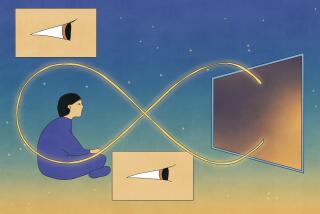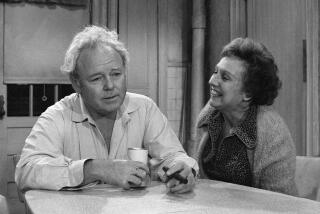Summing Up Half a Century of Tube-Watching
In summarizing recently a Daily Mail list of things the British did and didn’t have when World War II began in 1939 I was dubious that there were 20,000 TV sets in London.
I said, “An improbable number, it seems to me, for that year.”
David Starkman of Culver City verifies that there were indeed 20,000 TV sets in London in 1939, quoting from “Television--The First 50 Years,” by Keith Geddes and Gordon Bussey.
Quality telecasting had begun in 1936, according to the authors, and people were soon enjoying stage plays, opera and the 22-piece BBC television orchestra.
“Yet the number of viewers was too small for television to have any impact as a social force. A year after the opening only about 2,000 sets had been sold, and though sales increased with the introduction of cheaper models, so that by August, 1939, some 20,000 sets were in use, this was still only around one for every 600 people living within the service area. On 1 September, with war imminent, the service was unceremoniously closed down; its transmissions could have guided hostile aircraft to London.”
NBC inaugurated the first American service in New York in May, 1939; the German Post Office opened one in Berlin in July of that year.
Like a genie stuffed back into its bottle, the monster waited only for the war to end to come forth and change the world, which will never be the same.
In “TV Comes of Age,” last September’s Connoisseur magazine, which calls itself “The Guide to the Civilized World,” observed that “television, especially cable and the VCR, is the most vital and important cultural force in America today. Only snobs, pseudo intellectuals, and boobs do not recognize the fact.”
God spare me from being branded with any of those epithets.
The article has some astounding figures that show just how big television has become:
In one year television is watched in American households about 231 billion hours.
The telecast of Prince Charles and Lady Diana’s wedding in 1981 was seen by 750 million persons in 74 countries--about one-fifth of the world’s population.
The number that watched Neil Armstrong and Edwin Aldrin walk on the moon in 1969 was 720 million.
Evidently people with more money are less patient with TV programming. Households with incomes of less than $15,000 turn the dial on an average every 6 minutes, 15 seconds; households with incomes of over $75,000 turn every 2 minutes, 42 seconds.
Television is what we know and what we think: The percentage of Americans who get all their information about the world from TV is 70.
The number of Americans who say they do not watch TV is 8%; but the article guesses that “the number of hours per week watched by people who claim they do not watch TV is 10.”
TVs that are not included in the Nielsen ratings are those on college campuses, in hotels, bars, Army barracks and second homes. That is a lot of TV sets that don’t count. When TV sets in restaurants and bars were monitored, the increase in the viewership of ABC’s Monday Night Football was 2.8 million.
The highest-rated series ever was “Roots.” The biggest surge ever in water use in New Britain, Conn., occurred during the second commercial of the first episode.
Despite its enormous popularity and its domination of the culture, the article points out that nobody remembers much of what they have seen on TV. It recalls the shock felt when Tom Brokaw asked Sen. Robert Dole, during the 1988 campaign, if there was anything he’d like to say to George Bush, and Dole said, “ Yeah! Tell him to stop lying about my record!”
“Within hours, the moment proliferated (a hundred times over); it dominated the medium, seizing the evening news, hammerlocking the Sunday-morning news-yelling-and-analysis shows and then, needless to tell you, vanished--never to be recalled, even on public television. And 18 months later hardly any of us would remember it.
“Except for ‘Peter Pan’ and ‘The Wizard of Oz’ and a few other things, nobody remembers very much of what they have ever seen on television, start to finish.”
I don’t know about that. I doubt that anyone who saw it (over and over) will ever forget the Challenger explosion, or Kirk Gibson’s ninth-inning, two-out, two-strike home run in the first game of the 1988 World Series.
Somehow, also, for all its hold on the nation, I think that TV news is becoming more hoked-up and less believeable, and that the so-called situation comedy has reached bottom.
Doesn’t anyone remember Sid Caesar and Imogene Coca? Now they were funny.
And who could forget the many faces of Richard Nixon?
As Connoisseur said, “For 37 years, ever since his national debut, in 1952, he gave TV its most fully enunciated character, a challenge to any creation in literature or film.”
True. Few moments in literature or film can match that moment when he flew away from the presidency by helicopter.
The most depressing statistics, though, are these: The number of murders the average child sees on television by the age of 16 is 18,000; the number of commercials they see by 18 is 350,000.
What ever became of Beanie and Cecil the Seasick Sea Serpent?
More to Read
Sign up for Essential California
The most important California stories and recommendations in your inbox every morning.
You may occasionally receive promotional content from the Los Angeles Times.










